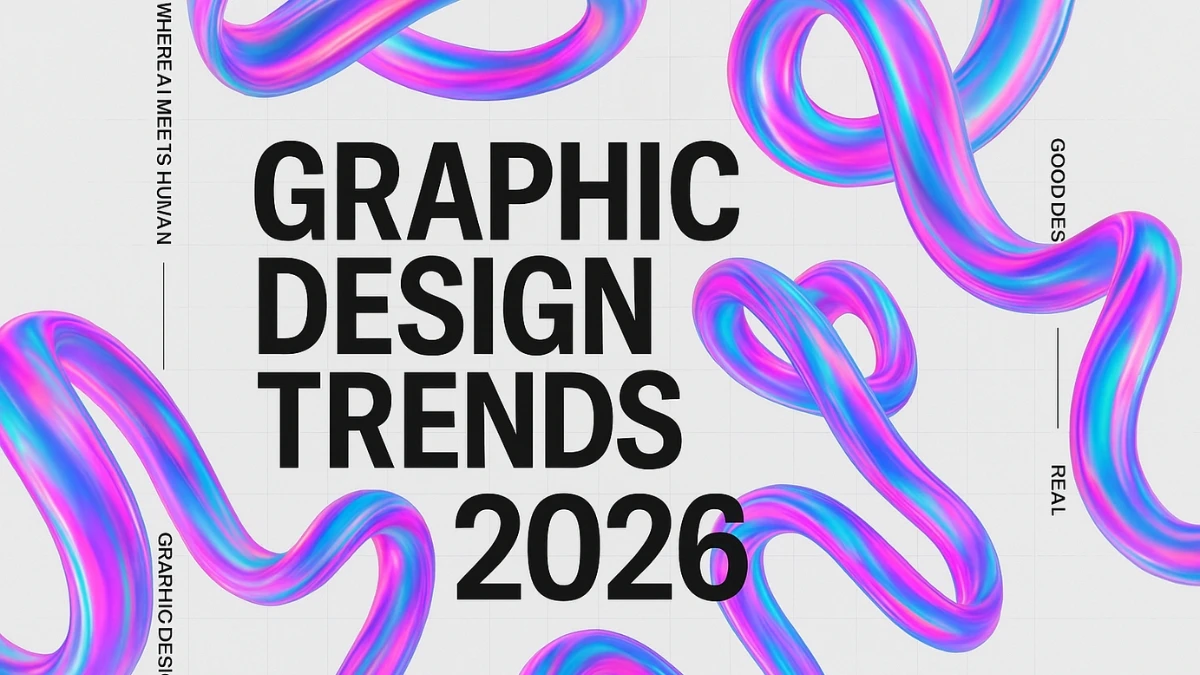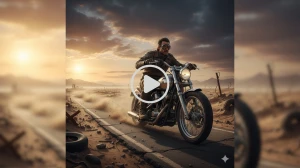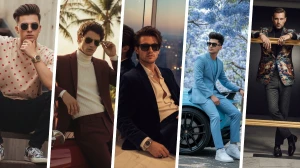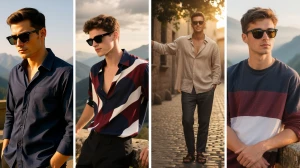A Glimpse into the Future of Graphic Design
The world of graphic design is constantly evolving, with new trends emerging every year that reflect changing technology, culture, and user needs.
As we move into 2026, the design landscape is brimming with exciting and innovative styles that push boundaries, blend the old with the new, and respond to our increasingly digital and interconnected lives.
From nostalgic references to bold, futuristic aesthetics, the graphic design trends for 2026 promise to be diverse and visually captivating. Whether you're a designer, a business owner, or someone who simply loves the art of visual communication, understanding these trends is crucial for staying ahead of the curve.
They will not only inform design decisions but also shape how brands, products, and ideas communicate with their audiences in a rapidly changing world. In this article, we will explore the top 10 graphic design trends for 2026 that every creative professional and design enthusiast should know.
These trends encompass everything from playful, pixel-inspired visuals to more conceptual, communication-focused designs, all reflecting the dynamic shifts in both aesthetic preferences and societal values. Let’s dive in!
1. Naive Design: Where Navigation Meets Pixel Art
Naive design is a standout trend in 2026, bringing a playful, pixelated aesthetic to the forefront. Drawing inspiration from early internet culture, retro video game graphics, and old-school digital displays, this trend blends the simplicity of pixel art with modern functionality.
It transforms ordinary digital interfaces into interactive, visually engaging experiences. Expect chunky pixels, bitmap fonts, and grid-based layouts that evoke nostalgia for the 8-bit and 16-bit eras, but with a sophisticated, contemporary twist. Ideal for tech startups, gaming communities, and digital brands, Naive design offers a fun yet functional approach to navigation and user interfaces.
Why It's Popular:
- The Naive design trend is a response to the sleek, minimalistic digital interfaces that have dominated recent years. It brings back the warmth and fun of vintage pixelated graphics while adding a modern twist with interactive elements, vibrant color schemes, and intuitive navigation.
- This design style is especially appealing to younger audiences, including millennials and Gen Z, who grew up with early digital experiences and are now looking for nostalgia in a more functional and engaging format.
2. Trinket Design: Organized Visual Collections
Trinket design (also known as index design) draws inspiration from the past, evoking the charm of Victorian cabinets of curiosities and scrapbooks. This trend showcases visual elements as curated objects or artifacts, carefully arranged in organized grid layouts.
Think of it as creating a visual museum where each design element contributes to a larger, cohesive narrative. Popular in branding, packaging, and editorial design, Trinket design creates rich, layered experiences.
Expect visually appealing collections of icons, illustrations, and other design elements, often paired with minimalist color palettes or a more maximalist approach.
Why It's Popular:
- With the growing trend of minimalism, Trinket design offers a refreshing departure, embracing a "maximalist" approach. It gives room for creative storytelling through the arrangement of icons, illustrations, and other small objects.
- This trend works well for brand identity systems, editorial layouts, and product packaging, allowing designers to create visually rich experiences that feel both personal and organized. It appeals to audiences who appreciate complexity and depth in design.
3. Gradient Layouts: Smooth Transitions and Dynamic Flows
Gradients continue to evolve, moving beyond simple background effects to become key elements in structuring content. The 2026 version of gradient design emphasizes smooth, organic transitions, mimicking natural phenomena such as sunsets or the aurora borealis.
These gradients are used not only as decorative elements but also to guide the viewer's attention, separate content, and create depth. Expect gradients that subtly shift as users interact with content, creating a dynamic and immersive experience.
The color palette is becoming more experimental, featuring combinations like olive-to-coral or sage-to-terracotta, offering visually stimulating and harmonious transitions.
Why It's Popular:
- Gradients create depth and dimension in designs without relying on heavy 3D effects. The smooth transitions between colors add an organic feel to digital environments, making them more engaging.
- This trend appeals to designers who want to add a sense of movement or emotion to their designs without overwhelming the user.
- Gradients are particularly effective in web design, as they can subtly shift as users interact with the content, enhancing the overall user experience.
4. Fuzzy Amorphous Creatures: Organic, Playful Forms
One of the more whimsical trends of 2026 is the rise of fuzzy, amorphous creatures – soft, blob-like characters with flowing outlines and tactile textures. These creatures bring warmth and personality to designs, serving as mascots, decorative elements, or interface components.
The organic forms of these designs evoke a sense of imperfection and human-like qualities, which make them highly relatable and approachable.
Particularly effective for brands targeting younger audiences or those in the wellness and creative sectors, fuzzy amorphous creatures represent a shift toward more friendly, engaging, and playful digital experiences.
Why It's Popular:
- Fuzzy amorphous creatures bring a sense of warmth and personality to digital and print designs. They are perfect for brands that want to appear approachable, especially in industries like wellness, education, and tech.
- The whimsy of these characters appeals to younger audiences, while the tactile textures and subtle animations (like gentle wobbles or breathing motions) bring the characters to life.
- This trend emphasizes imperfection and organic growth, which resonates in a world that increasingly values authenticity and individuality.
5. Acid Blur: Psychedelic Visual Distortions
Drawing from the psychedelic aesthetics of the 1960s, Acid Blur combines motion blur, chromatic aberration, and vibrant color shifts to create visually disorienting, dreamlike effects. This trend pushes boundaries by embracing digital psychedelia, where images appear as if viewed through a kaleidoscope.
Ideal for music branding, fashion, and avant-garde editorial design, Acid Blur creates a sense of altered states, challenging the norms of clarity and readability in favor of experimental visuals. However, when implementing this trend, it's important to strike a balance to ensure content remains legible and accessible.
Why It's Popular:
- As digital art becomes more immersive and experimental, acid blur taps into cultural interests in altered states, digital psychedelia, and the fusion of physical and virtual worlds.
- This trend is particularly popular in the music industry, fashion, and underground art scenes, where a sense of rebellion and boundary-pushing is essential.
- It’s a visual language that challenges traditional clarity and readability, offering an abstract and surreal experience that feels fresh and exciting.
6. Blurry Ethereal Florals: Soft, Dreamy Botanical Designs
Blurry ethereal florals offer a softer, more atmospheric approach to graphic design. By using soft focus, transparent overlays, and gradient effects, designers create botanical elements that feel dreamlike and abstract.
This trend works particularly well for wellness brands, beauty products, and lifestyle publications, providing a calming, romantic aesthetic.
The key is to embrace abstraction and mood rather than strict botanical accuracy, with a color palette that includes pastels, muted neutrals, and occasional vibrant accents. This trend celebrates subtlety and natural beauty in a way that invites contemplation and relaxation.
Why It's Popular:
- In an increasingly digital world, the blurred floral aesthetic offers a sense of softness and nostalgia, evoking a return to nature.
- It appeals to wellness brands, beauty industries, and lifestyle publications looking to convey a sense of serenity, mindfulness, and natural beauty.
- The trend aligns with contemporary movements in self-care and sustainability, making it particularly relevant in today’s design landscape.
7. Type Collage: Layered Typography for Impact
Type collage design is making waves in 2026 by taking typography beyond simple communication into the realm of visual expression. This approach involves layering multiple typefaces, sizes, and orientations to create dense, chaotic, yet expressive compositions.
Drawing from punk zines and street art, this trend prioritizes energy and visual impact over readability. It’s perfect for music branding, activism, and editorial designs that aim to communicate attitude, rebellion, and boldness.
Successful type collages maintain a careful balance between visual chaos and legibility, creating powerful, dynamic compositions that demand attention.
Why It's Popular:
- In a world of highly polished and streamlined digital content, type collage design provides an opportunity to break free from conventions.
- It allows designers to experiment with chaos and expression, creating compositions that feel vibrant and energetic.
- This trend is popular in music branding, activist messaging, and fashion design, where the focus is often on creating a visceral emotional response rather than clarity or simplicity.
8. Punk Grunge: Raw, DIY Aesthetic
The punk grunge trend is experiencing a resurgence in 2026, embracing raw, unpolished aesthetics that reject perfection in favor of authenticity.
This trend is characterized by distressed textures, photocopied effects, and hand-drawn elements, evoking the DIY spirit of the punk movement.
Designers use analog techniques like photocopying and scanning textures before digitizing them to achieve a genuinely imperfect look.
With its rebellious, unrefined energy, punk grunge resonates with audiences in underground music scenes, independent publishers, and alternative fashion brands, emphasizing authenticity and a rejection of corporate perfection.
Why It's Popular:
- Punk grunge appeals to those who value individuality and authenticity, providing a stark contrast to the clean, algorithm-driven designs that dominate much of the digital space.
- The trend celebrates DIY culture and rebellion against mainstream aesthetics, making it a favorite for alternative brands, underground music, and activist organizations.
- It speaks to audiences seeking raw, honest expressions that feel genuine and unfiltered.
9. Signal Graphic Design: Visual Communication Through Codes
Signal graphic design treats visual elements as a language in itself, creating systematic and purposeful designs that prioritize clarity and functionality.
This trend is inspired by semiotics, wayfinding systems, and data visualization, where every color, shape, and line weight carries specific meaning.
The design feels technical and precise, making it ideal for industries that prioritize transparency and clear communication, such as tech companies, transportation services, and educational institutions.
Signal design’s minimalist color schemes, geometric typography, and logical grid-based layouts ensure that every design element has a clear purpose.
Why It's Popular:
- It emphasizes clarity and functionality, making it ideal for industries that value transparency and direct communication.
- Its systematic approach, using purposeful color, shape, and typography, appeals to tech companies, educational institutions, and transportation services that need to convey information efficiently and effectively.
- The minimalist and organized aesthetic resonates with audiences seeking clear, navigable visual experiences.
10. Blueprint Design: Merging Technical and Artistic Elements
Blueprint design merges the precise, technical aesthetics of architectural and engineering drawings with contemporary branding.
The trend features clean, detailed linework, dimension annotations, and classic blue-and-white color schemes, often combined with modern graphic elements.
It’s particularly popular in industries like craft beer branding, construction, and artisanal products, where craftsmanship and attention to detail are valued.
Modern blueprint designs experiment with color inversions, hybrid styles, and photo integration to bring a technical yet approachable aesthetic to branding.
Understanding technical drawing principles is essential for creating effective blueprint designs that resonate with both precision and artistry.
Why It's Popular:
- Blueprint design speaks to a growing appreciation for technical expertise and craftsmanship in an increasingly digital world.
- It’s especially popular in industries like architecture, construction, and artisanal products, where the emphasis is on precision and process.
- By incorporating blueprint elements into branding, companies convey a sense of expertise and attention to detail, appealing to consumers who value quality and authenticity.
In conclusion, the graphic design trends of 2026 reflect a dynamic blend of nostalgia, innovation, and cultural commentary, pushing the boundaries of traditional aesthetics and embracing new forms of expression.
From the playful charm of Naive design to the experimental allure of acid blur, these trends highlight the growing desire for both authenticity and creativity in a digital-first world.
As designers continue to explore these diverse styles, they offer opportunities for unique, engaging visual storytelling that resonates with today’s audiences.
By staying attuned to these trends, designers can create impactful work that not only stands out but also speaks to the evolving cultural and technological landscape.
Disclaimer: The trends and insights presented in this article are based on current observations and predictions within the graphic design industry for 2026. As design trends are constantly evolving, some of the trends discussed may vary or change over time. The information provided is intended to offer inspiration and guidance, but should not be seen as definitive or exhaustive. Designers are encouraged to experiment and adapt these trends to suit their unique projects and audiences.






